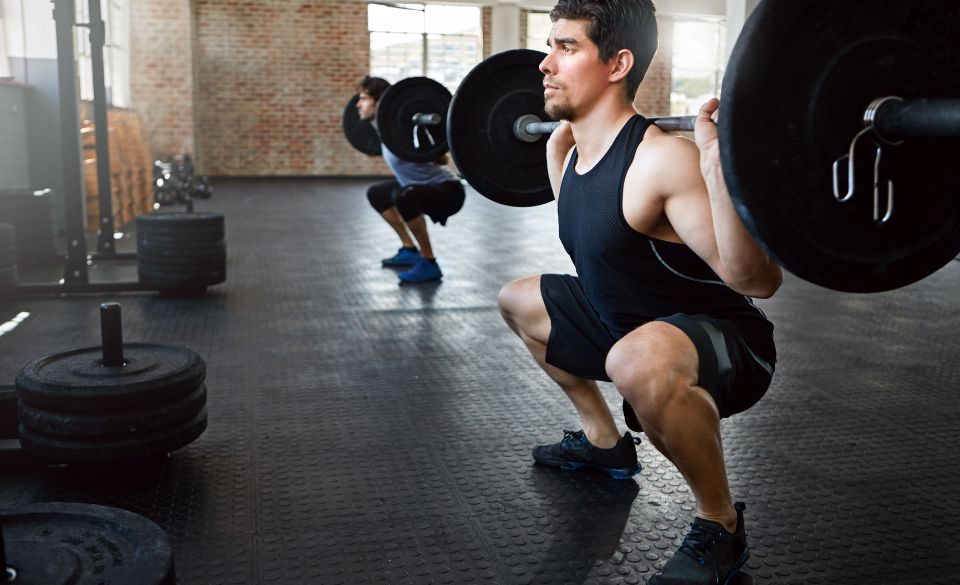
How Much Should Cyclists Squat? A Complete Guide
Page Contents
Cycling is an excellent low-impact form of exercise, which can help with weight loss, muscle development, and improved cardiovascular health. As cycling becomes more popular as a form of exercise, cyclists are becoming increasingly aware of the importance of strength training. And one of the most important exercises for cyclists is squatting. But how much should cyclists be squatting? Let’s take a look.
Benefits of Squatting For Cyclists
Squatting can be a great exercise for cyclists, providing them with numerous benefits. It is an easy-to-learn, low-impact exercise that helps build strength and stability, requiring minimal equipment and space. Many cyclists don’t pay enough attention to this exercise, but they should because of its many benefits. Here are some of the ways in which squatting can benefit cyclists.
1. Enhanced Lower-Body Strength
High-intensity squatting can provide cyclists with more power, acceleration and endurance. It builds strength in the quads and glutes, improving the efficiency of their pedaling. Squatting can also strengthen the muscles of the lower back, which support the core muscles used for stability when cycling.
2. Improved Balance
The strengthening of the core muscles has an additional benefit – improved balance. Good balance is essential for cyclists, both on the bike and in other activities, as it allows them to move quickly and safely over uneven terrain and obstacles. A stronger, more stable core also allows cyclists to maintain better positioning for more efficient pedaling.
3. Increased Mobility
Squatting increases the flexibility of the hips and quads, which helps to increase the range of motion of the lower body. This, in turn, can improve the speed and efficiency of pedaling. Squatting also helps to prevent stiffness and can help alleviate chronic pain in the lower body associated with cycling.
4. Injury Prevention
Squatting can also help to prevent injuries in other activities, such as running and weight lifting. This is because the increased strength, flexibility and stability it provides can help to reduce the risk of injury by reducing the load placed on vulnerable joints and muscles.
Squatting is an effective and low-impact exercise that can be beneficial to cyclists. It can help to increase the efficiency of their pedaling and the power of their accelerations. It can also help to improve their balance and mobility, and may even help to prevent injuries. So, if you’re a cyclist looking to get the most out of your cycling, don’t forget to add some squatting to your routine.
How Much Should Cyclists Squat?
In the long-running debate over how much cyclists should squat when they move to advanced training regimens, the answer isn’t always a simple one. The fact is, while various experts may have varying opinions on the subject, cyclists should ultimately decide how much they should squat based on what works best for their individual needs.
When talking about how much a cyclist should squat, the first factor to consider is the type of bike they are riding. Cyclists who ride mountain bikes will generally require more squat work than those who ride on the road. This is mostly because mountain bikers spend more time in rough terrain and the squatting motion helps them stay balanced and isolated from potential shocks and bumps. Road bikers, on the other hand, will require less squatting, as the terrain is generally smoother and allow for more efficient coasting.
The second factor that plays a role in how much a cyclist should squat depends on the weight of the cyclist. Generally speaking, heavier cyclists require more squatting than lighter cyclists. This is because the squatting motion helps the cyclist to increase their power output, especially when negotiating sharp ascents. This power output is much harder to generate when a cyclist is carrying large amounts of weight, so it is important to include appropriate amounts of squatting when training to ensure that power output is adequate.
Furthermore, a third factor to consider is the cyclist’s endurance level. Those with higher levels of endurance will require more squatting as they will likely be spending extended periods of time on the bike. Lower levels of endurance may require less squatting, as long as the cyclist’s power output is still sufficient.
Finally, the age of the cyclist is important in determining how much should be squatted. As we age, the body gets less flexible, so older cyclists may not be able to squat as deeply as younger ones, and should focus their efforts on achieving a more shallow squat that is free from any discomfort or potential pain.
Ultimately, the amount of squatting a cyclist should do will depend on a variety of factors, such as the type of bike being ridden, the cyclist’s weight and endurance level, and their age. While it is recommended to consult with an experienced coach about what amount of squatting is best for each individual, the most important thing is to make sure to listen to the body and to work with what is comfortable, safe, and efficient.
Types of Squats For Cyclists
Squats are a great exercise for cyclists as they help to strengthen the legs and build core strength. Squats are a functional exercise that can be used to help improve cycling performance, as well as prevent injury. There are several types of squats that cyclists can do to target the different muscle groups and areas of the body used while cycling.
1. Bodyweight Squats: These are the most basic type of squats and are great for cyclists who are just getting started with their squat routine. They involve simply squatting down and then standing back up without any weights. This type of squat can be done with or without a barbell and can help to strengthen the legs and core muscles involved in cycling.
2. Front Squats: These are a more advanced type of squat and involve holding a barbell in front of the chest while squatting down and then standing back up. This type of squat targets the quads, which are important muscles for cyclists.
3. Hack Squats: This type of squat involves holding a barbell behind your back while you squat down and then stand back up. This type of squat targets the glutes and hamstrings, which are important for cyclists who need to generate power for pedaling.
4. Split Squats: These involve standing with one foot in front of the other and then squatting down and standing back up. This type of squat helps to strengthen the muscles in the legs and core, as well as improve balance and coordination.
5. Single Leg Squats: These involve squatting down on one leg and then standing back up. This type of squat helps to target the muscles in the legs, as well as the core and glutes.
No matter what type of squats you choose, they can all help to improve your cycling performance and prevent injury. Remember to always warm up properly before doing any type of squats, and focus on good form to get the most out of your workout.
Conclusion
Squatting is an essential exercise for cyclists, as it helps to increase muscle strength, improve power and stability, and reduce the risk of injury. However, there is no set guideline for how much cyclists should be squatting, and it will depend on your experience and strength. Generally speaking, experienced cyclists should aim to do 3 sets of 8-12 reps, with additional weight, while beginners should start with just their bodyweight.


